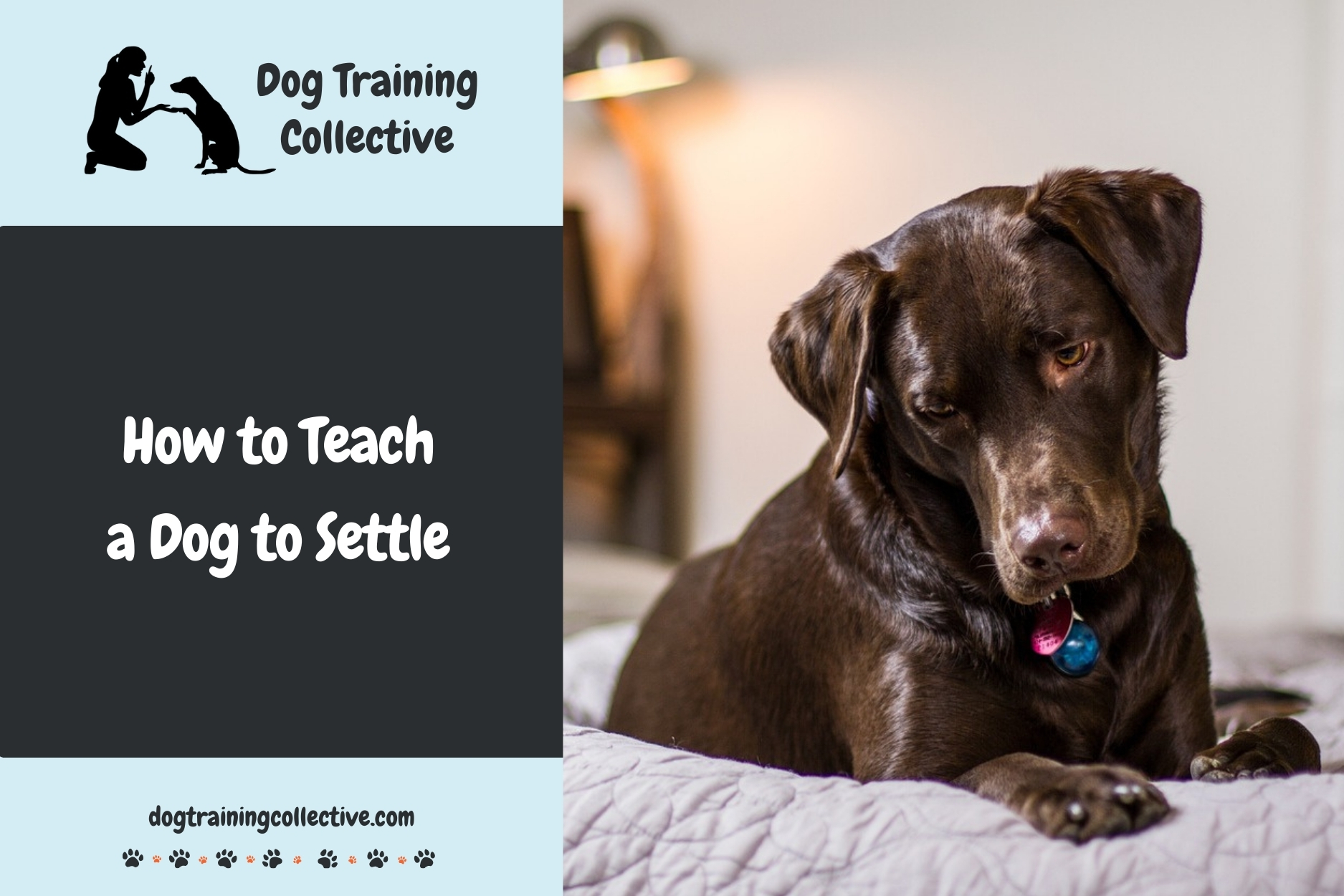Telling your dog to “settle” is to go and find a place and just relax, more often than not in a “down” position. The dog is laid down on the ground with both hind legs on either side of its body or lying on its side for long periods. Even though he might not show it, your pet will surely appreciate you for the respite since dogs aren’t used to doing two things at the same time.
By nature, just like all other warm-blooded mammals, dogs also need to have some other ways they can rest during their waking hours. That is, not having to spend the whole day being too excited and running around thinking that life is all that. Being overactive and agitated all the time can be destructive for your dog, especially for your furniture. Not to mention the stress it will have on your hair by having to call out your dog every time he is running slip-slide drifting across the hallway, not knowing when to stop.
Dogs that are trained to “settle” can lie or sit down. and relax. They are not doing anything in particular or are just about calmly sniffing around while their owners are busy doing something else. They don’t face their owners while trying to offer tricks in exchange for treats. They aren’t intentionally impatient, it’s just that when their commands are not balanced out, they tend to stick to what they can remember, and they try to see if they can play.
Can you imagine a dog going from ballistic to suddenly dropping off to sleep? Yes, he will need to learn how to relax. A relaxed mode, if not done naturally by your dog will then have to be taught by you. It will be beneficial for you and him in the long run.
Why is it Important to teach a dog to settle?

Having a dog that knows how to relax is also part of his social skills. He will, to some extent be connected to you in such a way that he can sit beside your feet in a café while you are relaxing and sipping on a cup of coffee. He will be trained enough to calmly ignore the cars and all the other people who are passing by. As long as you are calm and he is trained, he can enjoy the rest of the afternoon in a relaxed mode just like you.
Having a “settle” command prevents dogs from demanding food by constantly offering “behaviors” that generally will reward them with treats. Being able to relax on command becomes a part of his social skills. This is especially useful for your dog not to get confused when sometimes they don’t get treats for no reason at all and are being “ignored”.
Teaching your dog to “settle” by giving them an alternative and still making them think they are doing something for you, is the best way to keep your dog connected. It keeps him calm and well-behaved. at the right place and at the right time. Your pet won’t mind spending a boring afternoon doing nothing, as long as it’s with you. Dogs are like that, they give you that kind of friendship that you’ll never forget.
How to Train Your Dog to “Settle” on Command
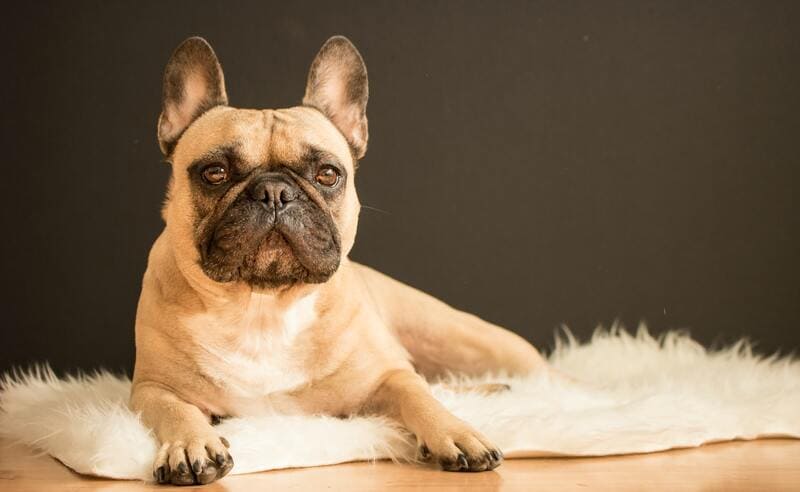
The “settle” cue is one of the most important commands in basic obedience. A rowdy pup or adult dog is difficult to train when it is constantly in hyper mode. Naturally, they also tend to pay more attention when they are calm and subdued.
There is one of two ways how you can effectively teach your dog to “settle”: (you can choose one method over the other)
- Method 1: Using a “Dog Bed” or a Mat Through Lure Method
- Method 2: Using a Leash and a Mat through Capture Method
Basic Commands
- “Down”: On the assumption that your dog already knows how to do “down,” you will use this command as a supplement to have your dog lie down on cue.
- “Settle“: “Settle” is a verbal cue for your dog to follow whenever you are ready to sit down or do something else. That means, doing things that will require your full attention away from your dog. and at the same time, keeping him calmly under control. It can be accompanied by a slight hand signal using your index finger to point to the place where you want your dog to “settle”.
- “On the bed”: This command is an alternative cue that you can use when you are telling your dog to get on his bed
- “Lie down” or “Down”: A basic command that can also be used to supplement the “go to bed” command”. This is done by asking your dog to lie down on the bed and stay until such time you release him.
- “Yes“: Used as a verbal marker whenever your dog performs the correct desired behavior.
- “Okay”: Verbal cue to release your dog from the “settle” or “on the bed” command.
- “Good” (“girl” or “boy”): Verbal praise given right after your dog is released for a job well done.
Equipment you will need
- Any mat or Square Rug: It can be a mat or a portable rug that you can take with you to any part of the house that is to be used as your dog’s bed. Or, you can buy a reasonably priced dog bed online as well as from your local pet store. It will also serve as a visual cue/object for your dog to relax.
- Dog Collar and a long leash (5 to 10 feet long) to put your dog in training mode.
- Treats and a Treat Pouch: Carry your dog’s favorite kibbles and a few pieces of some of his high-value treats such as cheese or frozen liver which are used for both lure and reward in performing the desired behavior. The pouch is a small waist bag that contains the treats for easy access.
- Clicker (optional): An instrument that produces a clicking sound to mark the desired action.
Method 1: Using a “Dog Bed” or a Mat Through Lure Method.
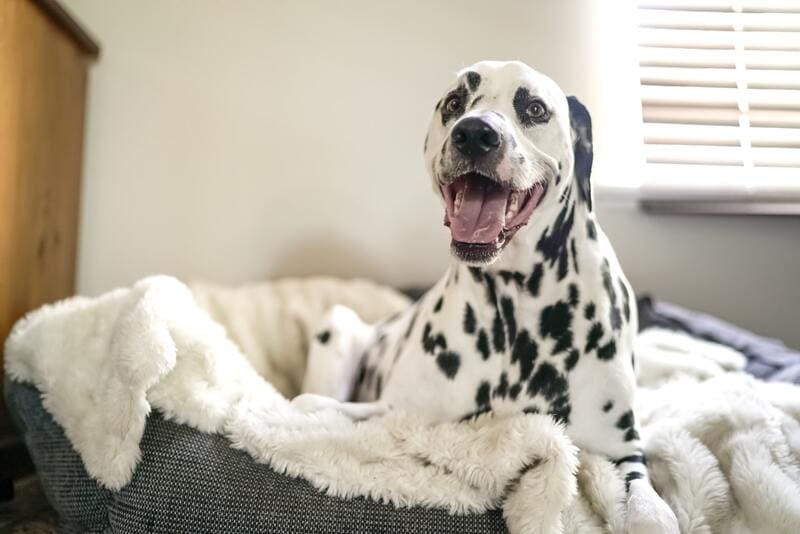
We recommend that this stage comes first for the reason that most of your dog’s training will start from the inside of your house, as well as all the other important commands. You can set your dog up for success by beginning training with little to no distractions.
Step 1: Start in a Quiet Location
First, decide on a place in the house where you and your dog can be in the same room and be both quiet and relaxed. You may put the dog bed in the living room where you do some of your work, near your couch, or maybe somewhere near the warmth of the fireplace. Use a mat or a small square carpet for a bed that you can fold and later take with you anywhere in the house.
Step 2: Lure your Dog on the Mat
Show your dog his mat and lay it on the floor. Use a treat to lure your dog onto the bed, Then, as he follows your hand while hopping onto the bed. mark his action with a “yes” and Immediately reward him with the treat while he is still on the bed.
Next, release him by saying “okay” and simultaneously tossing a treat somewhere a few feet outside of the bed. This is just to get him off the bed and show him the difference between the floor and his mat. You can also use a clicker in place of the verbal marker “yes” as you prefer. As he goes after and eats the treat outside of the bed, don’t forget to give him verbal praise such as, “Good girl!” or “Good boy!”
Step 3: Add the Verbal Cue “Go to Bed” and “Down”
As you are repeating the exercise, add the verbal cue “go to bed” or “settle” so your dog will begin to associate it with hopping into the bed.
Again, repeat the cycle of rewarding him in and out of bed so he gets the feel of when and where he is going to be rewarded on both sides. This will prepare him for the next step which you will level up to, as he responds faster and eventually tries to offer the behavior.
Say “Go to bed”, then when he hops on it, add the verbal cue “down” to have him lie on the bed and stay there.
Step 4: Emphasize Being on the Bed by Giving More Treats While Being on It
While your dog is “down” on the bed, grab a handful of kibbles and start feeding him pieces of treats in steady succession. Assuming you have 6 kibbles in your left hand, feed him all six one after the other at a normal pace. The purpose of rewarding him this way is to emphasize the long duration of staying on the bed or mat. It’s a kibble party for your dog as he enjoys more treats the longer he stays in bed.
Keep feeding him the treats until all of them are gone on your other hand. Then, say “okay” to release him and give him a treat when steps off the bed. How you give the treats should be normal and calm, one after the other just like clockwork. This is so that your dog won’t get too excited and will learn to wait and be calm as he lays on the bed.
Do these steps with the goal in mind that your dog will get used to lying in bed voluntarily for longer periods at his owner’s cue
Keep on repeating the exercise of giving your dog more treats whenever he is down on the bed.
Up the Challenge by increasing distance and duration
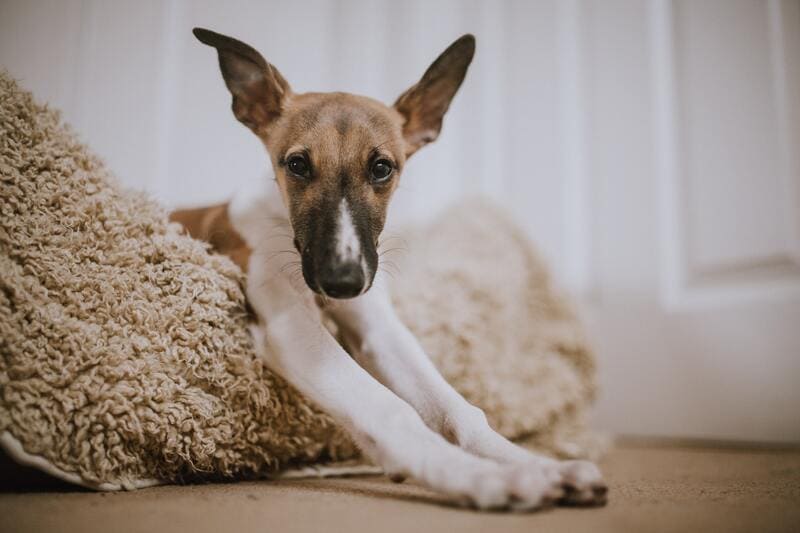
Step 1: Increase the Duration
Gradually increase the time between the desired behavior and reward. This is to make him stay on the bed longer. First, wait for a few seconds before the reward, then increase to a few minutes until he learns to willingly stay calm.
Step 2: Add Distance
At this point, your dog may already be able to stay on for a few minutes at a time. Have your dog lay down on the bed and feed him at least 1 or 2 kibbles then walk away about a few feet from him. If he doesn’t get distracted, reward and praise. Gradually increase the distance as desired.
Step 3: Repeat
Keep repeating the exercise with longer periods in between walking away and going back to reward your dog. Don’t forget to release him sometimes to emphasize what it is like being outside of the bed. You must reward him 90% of the time when he is on the bed.
Step 4: Fade out the Treats
Gradually remove the lure and just give the verbal cue. Remember to use your clicker or mark with “yes”, every time he does the behavior correctly. Consistently apply verbal praise.
Always remember to be calm and not to be too excited when rewarding your dog so that he will continue to associate the reward with being calm and quiet.
Read also: How to Teach a Dog to Stay Off the Couch, Bed, and Furniture
Method 2: Using a Leash through Capture Method
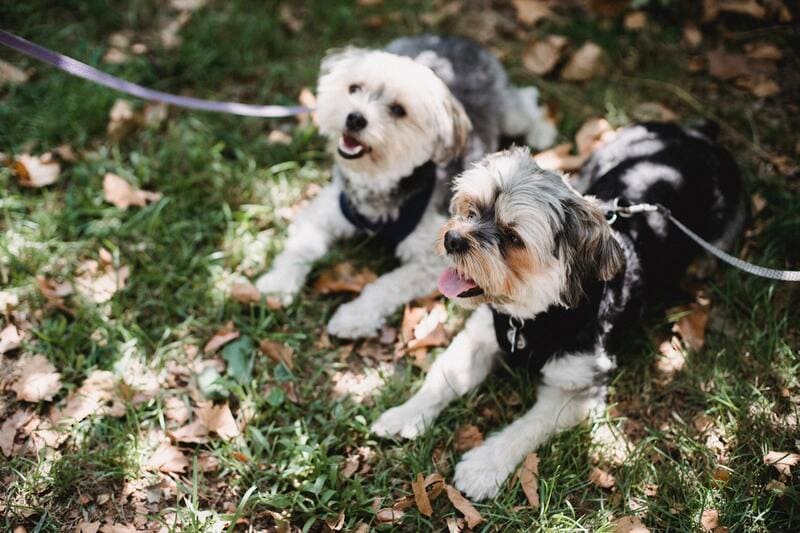
This method will be useful whenever you are outside and a lot of distractions are present.
Step 1: On your first day, we recommend training indoors to avoid distractions or at least keep them low. Spread the mat for your dog and get your line/leash ready. At first, your dog might ignore it and will continue to be active
Step 2: Don’t call your dog, just observe and pretend not to pay any attention. When he at least comes near the mat and shows some interest in it, reward him by throwing a treat on the mat. Remember to reward him only when he is on the mat.
Step 3: Put him on the leash and roll up the line to shorten the leash by about 1 and a half feet. Holding him at a very short distance effectively keeps him on the mat and prevents him from going anywhere else. Don’t say anything, just hold his leash as he is on the mat.
Step 4: When your dog is kept in that loosely restrained position most dogs would look at their owner with eyes asking: “Where are we at?” Most of them won’t protest, instead, they will stay still and eventually get bored and lie down on the mat. Immediately reward with verbal praise or with a stroke of his fur to help him relax.
Step 5: Exceptions. If your dog is a puppy or is unusually active, you might get kissed in the face with no sign of letting go. Your dog is not going to calm down because of excess energy. You can then take off some of that energy by playing games like fetch or any other game that your dog loves. Once your dog has had enough repeat the steps.
Step 6: Capturing Desirable Behaviors. As your dog is on the mat and is busy scratching or sniffing at the mat. Do not make eye contact but wait for signs of voluntary relaxation. Reward him with treats for the following behaviors:
- When he lies down on the mat
- Puts his head down on the rug
- Exhales deeply as if to relax
- Other behaviors that keep him on the mat as well as being calm.
Step 7: Begin extending the gap between behavior and reward to establish more time on the mat. The longer the gap, the more your dog will get used to relaxing on the mat. Do the gap only enough to keep his attention. Don’t wait for him to get bored and walk away. Give your dog a break from time to time by saying “okay” and releasing him. When he comes back, repeat the exercise. Later, you can remove the leash depending on your dog’s progress.
Step 8: Repeat this exercise according to how your dog progresses. This will require a lot of time and patience since you will be there to “capture” desirable behavior. Remember to keep the rewards on the mat, so your dog will anchor food while relaxing on the mat.
Step 9: Later you can add on “settle” as a command and slowly fade out the treats as your dog masters the behavior. He will finally be able to lie down beside your feet at a cafe on a lazy afternoon or in a park with not much fuss.
Read also: How to Train a Dog Not to Pull on the Leash | a Step-by-Step Guide
What is the Difference Between “Settle” and “Stay”?
For your dog to be settled means, doing his own thing even when you are around. He is not wandering off but is only at one place in a “down” position. On the other hand, a “stay” has your dog facing you, waiting for your next instruction. A stay will often be short and will most likely require a quick release. Conversely, a “settle” release may come at any moment as your dog is trained to relax for longer periods of time.
Read: How to Teach Your Dog to Stay [Step-by-Step]
“Settle” Command TROUBLESHOOTING: What are the common mistakes?

If seemingly your dog cannot relax here are a few possible reasons and what you should avoid:
- You may be sounding too excited especially when rewarding. Try to use a low calm and steady voice even when rewarding. Unique to dogs is their sensitivity to what their owner’s current state is. If you are angry, your dog will tend to be aggressive too. If you are excited they too will become very happy and active.
Relax and your dog will follow suit.
- Don’t start the first day of training in a very distracting place like the park. Train indoors with little to no furniture to break, and your dog is not likely going to pay for it.
How Long Does It Take to Train a Dog to Settle?

Since “settle” or “to the bed” is part of the list of basic commands, it should take about 1-2 weeks for your dog to learn and take this cue to heart.
Training a puppy to settle
For basic commands, most puppies would be eligible for training within 7 to 8 weeks of age. For some, the earlier the better, and for others, it would have to be more than 8 weeks of age since some breeds tend to have a very short attention span than usual as a puppy. But, yes you can ahead and teach your puppy how to relax. Bring lots of patience and be ready to spend extra time.
Train your puppy 3 times a week with 2 to 3 sessions per day, at 5 minutes per session.
Training an adult dog to settle
For adult dogs, 1-2 weeks of training for the command “settle” could go either way. It could become too long or may need to be extended. You can observe your dog’s progress and use it as a basis to move along to the next step. Considering the restraint required to perform this command, you have to be patient with your adult dog too. They weren’t meant to be dozing off all day.
Train 3 times a week at 2-3 sessions per day, going at it at 15 minutes per session. Senior dogs could go either way too. They could already be older and a little slower, or they might have some aggression habits that you will need to work on. Again, patience is key, coupled with plenty of treats.
How Do I Train my Dog to Settle Without Treats?
You can train your dog with very little treats substituting it with long strokes on his back which would help him relax as well. Use food treats very sparingly as a backup and fade them out earlier as your dog learns to relax when given just the command “settle”.

